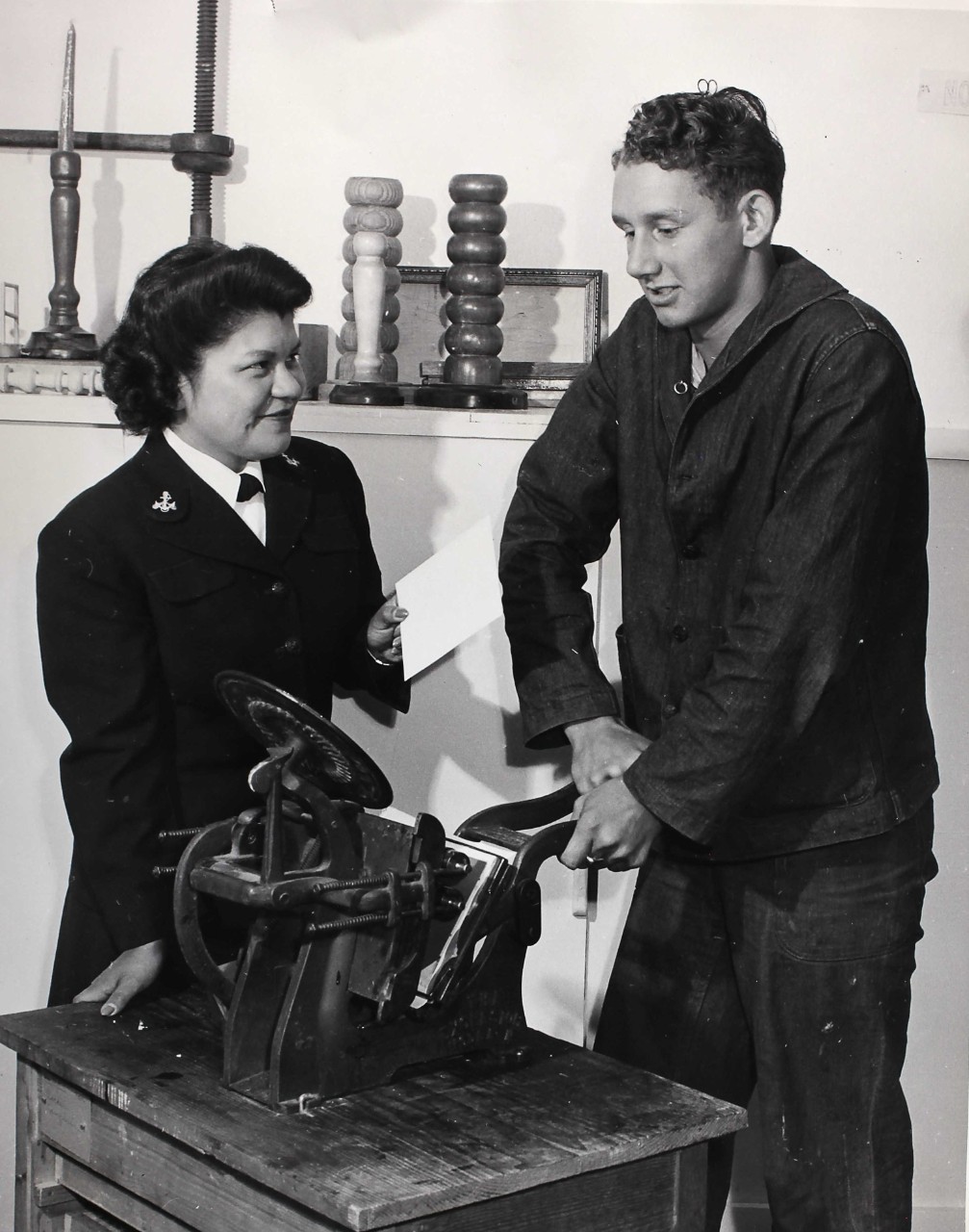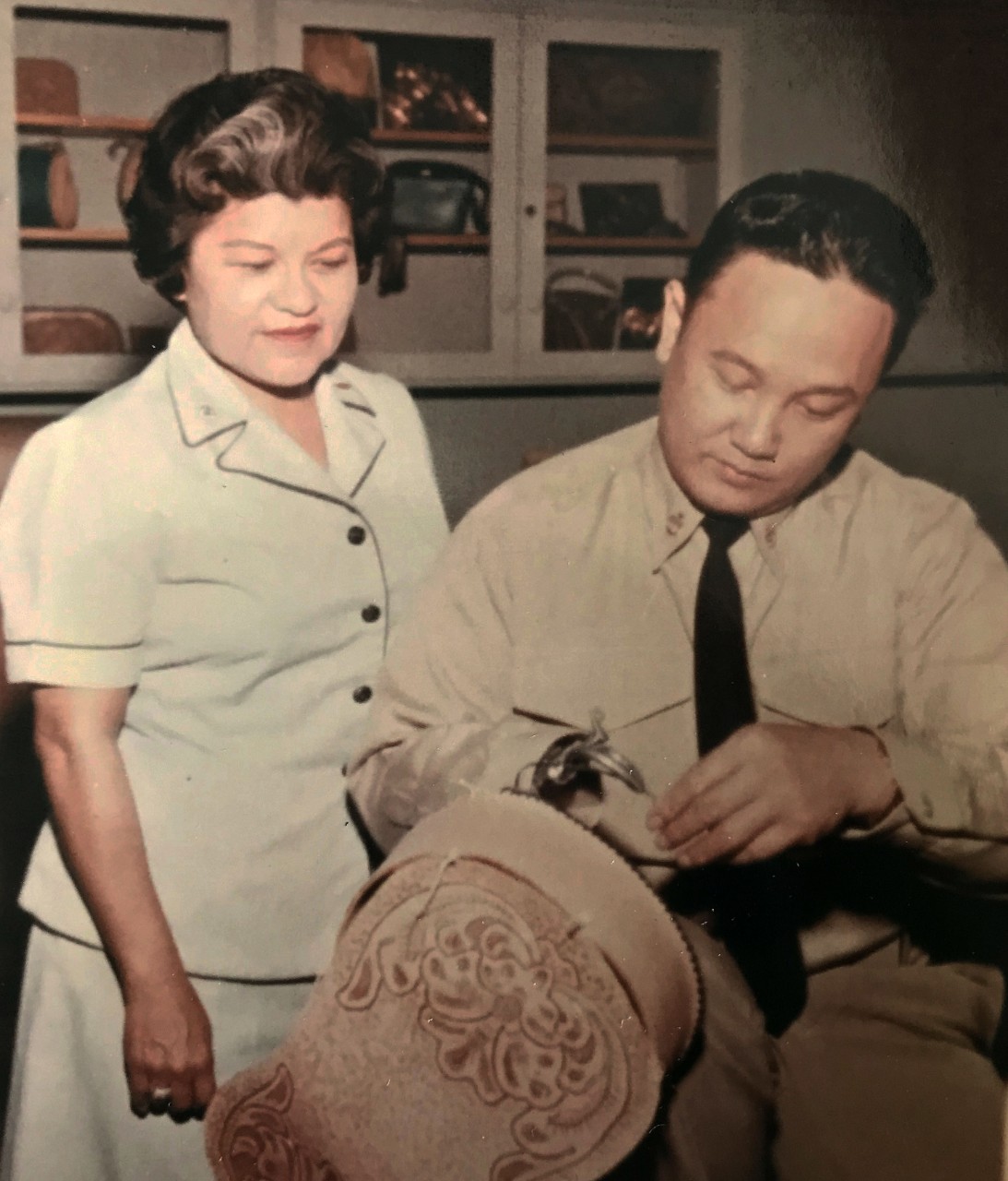Lieutenant Commander Maria Emiliana Aquino

Maria E. Aquino, WAVE Pharmacist's Mate Second Class, helps Jack Wiesen, Seaman Second Class, with printing work at the naval hospital in San Diego, California, c. 1942–45. Official U.S. Navy photo held by New Mexico Commission of Public Records, State Records Center and Archives (Santa Fe, NM).
Born on 27 June 1916, Emiliana (Emily) Aquino was of the Tewa-speaking people of the pueblo of San Juan (Ohke).1 She was the daughter of Delfido and Juanita Aquino. Her father served twice as the governor of the San Juan Pueblo.2
Aquino began her education at the reservation where she was born. She attended the San Juan Day School until she was 10. However, her father was among those Pueblo parents who saw the value of sending his daughter to a boarding school to continue her education and to learn how to engage with the Anglo-American population.3
Starting with high school, she attended the Santa Fe Indian School. She was encouraged by the administration at the Santa Fe Indian School and then the University of New Mexico (UNM) to help her culture and her people. The administrators tried to assist her with obtaining an educational loan to attend Columbia University in New York. When this plan did not work, they helped her to secure admission at UNM in Albuquerque. She graduated in 1934 with the first senior class of the Santa Fe Indian School.4
Following her graduation, Aquino started as a freshman at UNM. She studied art, but her career path remained uncertain. She continued to receive encouragement to share her culture with the Anglo-American community. She taught arts and crafts at Camp Kahlert in Maryland for a summer while in college.5 She was involved in the honorary art fraternity Delta Phi Delta, serving as its treasurer.6 During her junior year, she applied for and received a scholarship offered by the Colonial Dames of America to study nursing.7 In June 1939, Aquino graduated with a bachelor of arts degree with a major in art and a minor in psychology.8 She was among several early Pueblo graduates from area colleges.9
While studying nursing in Philadelphia, Aquino specialized in occupational therapy. This career path allowed her to apply her skills in art and education to helping individuals through rehabilitation. After graduating, she worked for the Indian Health Service under the Department of the Interior. The New Deal policies enacted by President Franklin D. Roosevelt led to an increase in appropriations to provide health services to Native Americans. Aquino first reported to a tuberculosis sanatorium in Rapid City, South Dakota.10 She was not there long before war broke out in 1941.
On 10 January 1943, Aquino joined the U.S. Naval Reserve (Women’s Reserve). Her father, her only living parent, did not approve of her decision to join the service.11 Although she possessed a college degree and trained occupational therapists (OTs) were in high demand, she was not selected for officer candidate school. After basic training, she most likely attended the Hospital Corps Rehabilitation School at Hunter College in New York before receiving her first posting as an occupational therapy assistant.12 During the war, she advanced to pharmacist’s mate second class in the WAVES.13
Aquino received her commission as an ensign on 26 September 1944, assigned to duty at the naval hospital at Bethesda, Maryland.14 She was promoted to lieutenant, junior grade, in 1946.15 In 1948, she was among one of the first 288 women commissioned as officers under the new Women’s Armed Services Integration Act.16 She was the first OT in the Navy’s Medical Service Corps and in the regular Navy.17 She was also the first Native American woman to serve as an officer in the Medical Service Corps.

Lieutenant Commander Maria E. Aquino supervises a Navy chief petty officer working on an occupational therapy exercise for amputees. Date of photograph unknown. (U.S. Navy Bureau of Medicine and Surgery Historian's Office.)
Aquino was promoted to lieutenant in July 1949 and to lieutenant commander in September 1957.18 At the end of her career in the Navy, she was serving as the head of a group of neuropsychiatric therapists at the naval hospital in Philadelphia.19 She retired in July 1964.
She passed away on 10 February 2004. She is buried in Santa Fe National Cemetery.
—Kati Engel, NHHC Communication and Outreach Division
***
Notes
[1] Since 2005, this pueblo now known by its pre-Spanish name, Ohkay Owingeh Pueblo.
[2] Albuquerque Journal, 22 January 1974.
[3] John R. Gram, Education at the Edge of Empire: Negotiating Pueblo Identity in Mexico’s Indian Boarding Schools (Seattle: University of Washington Press, 2015), 17.
[4] File Unit: Aquino, Emily (74607035); Student Case Files, 1910–1934; Records of the Bureau of Indian Affairs, 1793–1999, Record Group 75, National Archives and Records Administration–Denver (Broomfield, CO).
[5] Albuquerque Journal, 25 September 1936.
[6] Albuquerque Journal, 8 October 1938.
[7] Evening Star (Washington, DC), 27 July 1958; National Society of the Colonial Dames of America, Historian’s Report (1941), 75.
[8] University of New Mexico (UNM), Mirage (Albuquerque, NM: UNM, 1939), 31; University of New Mexico Bulletin, Forty-Ninth Annual Catalog Issue, 1939–1940 (Albuquerque, NM: UNM, 1940), 131
[9] Joe Sando, Pueblo Nations: Eight Centuries of Pueblo Indian History (Santa Fe, NM: Clear Light, 1992), 136.
[10] Evening Star, 27 July 1958, 87; Santa Fe New Mexican, 2 October 1944.
[11] Evening Star, 27 July 1958, 87.
[12] Bureau of Naval Personnel, Training Bulletin, 15 September 1945, 39,
[13] Aquino, Emily (8.19), Photographs; Box Number: 13630, Box Title: Photographs, individuals - by file number 001–132, New Mexico Commission of Public Records, State Records Center and Archives (Santa Fe, NM); Ancestry.com.
[14] Santa Fe New Mexican, 2 October 1944; United States Military Registers, 1902–1985 (Salem, Oregon: Oregon State Library, 1955), Ancestry.com.
[15] Department of the Navy, Register of Commissioned and Warrant Officers of the United States Navy and Marine Corps (Washington, DC: Government Printing Office [GPO], 1949), 474.
[16] Las Cruces Sun-News, 21 September 1948.
[17] Until 1965, this specialty was restricted to women.
[18] Register of the Commissioned and Warrant Officers of the United States Navy and Marine Corps (Washington, DC: GPO, 1954), 378; Department of the Navy, Register of Retired Commissioned and Warrant Officers of the United States Navy and Marine Corps (Washington, DC: GPO, 1970), 13.
[19] Evening Star, 27 July 1958, 87.
Further Reading
Grace May Gouveia, “‘We Also Serve’: American Indian Women’s Role in World War II.” Michigan Historical Review 20, no. 2 (1994): 153–82.
“Native Women and World War II,” Why We Serve: Native Americans in the United States Armed Forces, National Museum of the American Indian, Smithsonian Institution, accessed 14 November 2022.
André Sobocinski, A Look Back at the First Women in the Medical Service Corps, last updated 10 August 2021.


